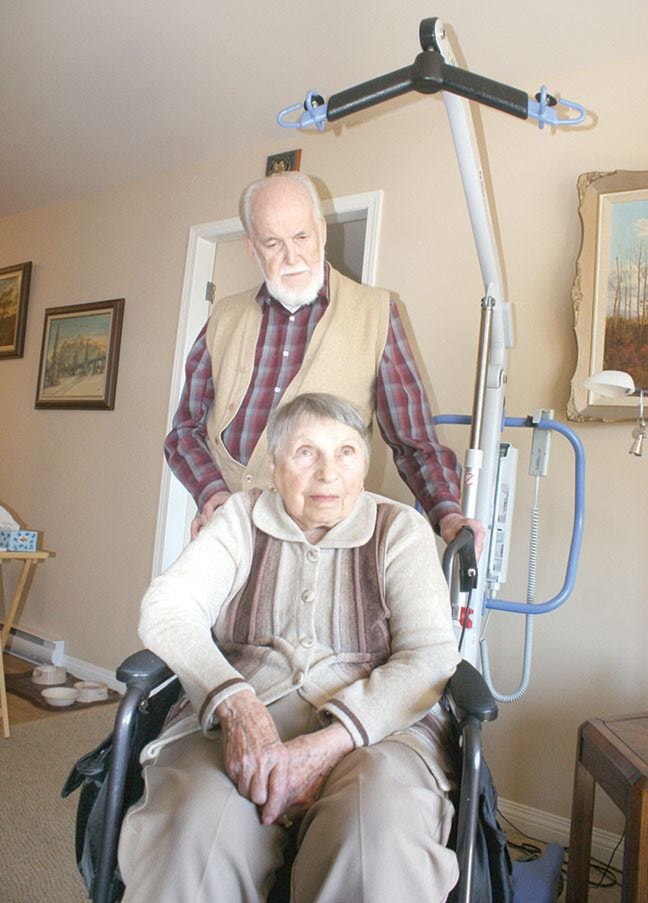Deb Paterson is concerned that a technicality at Retirement Concepts is going to reduce medical expenses that seniors such as her parents can claim on income tax returns.
Her parents, Doug and Rose Steedman, have resided at the Comox Valley Seniors Village (Casa Loma) since Dec. 1, 2010. It’s owned by Retirement Concepts. A contract classifies the couple as assisted living.
Paterson, herself a senior, has met several times with the company.
“I did my father’s income tax and now he owes four grand this year,” she said. “I don’t know why.”
Rose, 91, has been in a wheelchair since 2011 due to various medical conditions. Doug, 83, is in “fair condition” but Paterson says her father can no longer cook, clean or tend to Rose full-time, which is why they are in assisted living.
When she first lived at Casa Loma, Rose was using a walker. She now requires a lift to transfer from her bed to a wheelchair. She is also legally blind, and struggles to hear even with hearing aids.
“She has nursing assistance each morning. I would hardly class that as independent living,” Paterson said.
A significant amount of her parents’ $4,000-plus per month rent pays for access to medical and non-medical attendants. These fees are tax deductible by seniors.
“We put my mom and dad in there so they could get the help. We’re willing to pay for it. But they should be getting some sort of a deduction for all these attendants that they’re paying for, and they were, until February when we went to get this year’s income tax receipt.”
In February, receipts from Retirement Concepts said attendant care expenses were zero for her parents. Doug was told they were no longer classified as assisted living. The receipt stated independent living.
A second invoice said assisted living and zero expenses.
“How can that possibly be?” Paterson said. “I don’t know what they’re playing at. They are still charging the rent but they’re not giving any offsetting write-offs for the amount of rent they’re charging.
“They (Retirement Concepts) have 23 homes across B.C. and Alberta. Can you imagine how many seniors this is affecting? This is huge for all of their residents that the government doesn’t fully subsidize.”
The family believes it all stems down to the fact that Doug out-sources for some recently approved extra assistance, as opposed to using the Retirement Concepts more costly in-house nursing.
Rose fell and broke her hip in October and after returning from the long-term care side of the Seniors Retirement Village to her own unit, she was receiving care for approximately a half-hour twice a day as she was – and still is – non-weight bearing.
Island Health had authorized up to four hours per day of assistance. The Steedmans felt that they did not need the full four hours (at a cost of $30 per hour) but were informed they could not get in-house service for any less than the maximum approved by Island Health.
“When we were told by the nursing staff of the Seniors Retirement Village via VIHA [Island Health] that they would only provide in-house care at a minimum of four hours of care, which we would have to pay for, we went to an outside agency for the maximum of one hour of care that my mother requires daily,” explained Paterson.
“We were then told that if we did not use their in-house personnel for care and pay extra for it, we would not be receiving the nursing care deduction even though nurses and nursing aides are on staff. The cost of these employees is paid for from their rent.”
Jami Brown, communications manager for Retirement Concepts, says the company has been conversing regularly with Paterson. She notes “very prescribed” Revenue Canada rules.
“We’ve been trying to define in particular the definition of assisted versus independent living,” Brown said. “The definitions of those differences are very tricky for people to follow. In their case, by definition, they are actually independent living residents of Casa Loma.”
Brown has suggested Paterson contact the Assisted Living Registrar, a government office that can help clarify the definition.
According to the ALR, assisted living is housing which supports adults by providing one or two prescribed services (assistance with medications, dressing or bathing) and five hospitality services (meals, housekeeping, laundry, recreation, emergency response system). There is no statutory definition of independent living. The term generally describes a senior who is not receiving any prescribed services and therefore is not in assisted living.
“What’s becoming a bit of a phenomena for us is, families are saying, ‘I see my mom have a wheelchair’ and ‘I see my mom with a walker.’ How can you possibly say that she’s independent living? Under the regulations, it’s certainly more complicated than whether or not the family deems them or thinks they are assisted living. That’s our challenge, is trying to provide accurate information. At the same time, we want families to feel confident in the information they’re being given.”
Which is why Brown has suggested Paterson seeks a third party, such as the ALR, to explain how things work.
“We are still in conversation with this family around the confusion concerning the tax receipts. We want to make sure that what we provide for them is adherent to any tax laws. We have clearly communicated to the family that they discuss this with a tax advisor.”
Paterson is to meet May 8 with Comox Valley MLA Don McRae, who encourages anyone with similar concerns to contact his Courtenay office at 250-703-2422.
